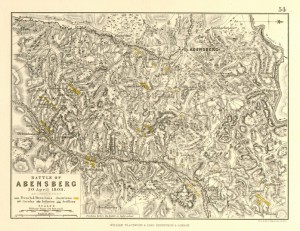Le stampe di battaglie napoleoniche proposte dalla Camelot nascono dalla trasposizione ad alta definizione su fogli pergamenati delle mappe edite nella seconda metà dell’Ottocento per l’Atlante di Storia Militare ad uso del Principe di Edimburgo e riportano fedelmente sia gli elementi del terreno che le formazioni in campo ed i loro spostamenti.
The napoleonics battlemaps produced by Camelot are accurate reproduction on forel of the ones printed in the Military battle atlas in the second half of the 19th century for the Prince of Edimburgh.
TREBBIA (1799)
Suvorov colpisce ancora! Dopo aver insegnato agli austriaci l’uso delle colonne, distrugge due armate francesi in tre giorni riconquistando in pochi mesi tutto ciò che Napoleone aveva ottenuto in Italia dal 1796.
 Seconda battaglia della campagna sul fronte austriaco, venne vinta dalle forze francesi che costrinsero le forze dell’Arciduca Carlo a ripiegare sulla sponda settentrionale del Danubio.Second battle of the austrian campaign in Baviera, was won by the Grande Armée forcing the Austrian army to retreat on the Danube’s northern river-bank.
Seconda battaglia della campagna sul fronte austriaco, venne vinta dalle forze francesi che costrinsero le forze dell’Arciduca Carlo a ripiegare sulla sponda settentrionale del Danubio.Second battle of the austrian campaign in Baviera, was won by the Grande Armée forcing the Austrian army to retreat on the Danube’s northern river-bank. L’assedio di Gerona, bloccando buona parte delle forze francesi in Spagna, diede agli alleati la possibilitàdi riprendersi ed torneare all’offensiva.The siege of Gerona forced so many french troops aropund the city that the allied had the capability to reorder their forces organizing their offensives.
L’assedio di Gerona, bloccando buona parte delle forze francesi in Spagna, diede agli alleati la possibilitàdi riprendersi ed torneare all’offensiva.The siege of Gerona forced so many french troops aropund the city that the allied had the capability to reorder their forces organizing their offensives. Fu conquistando Tarragona, che Souchet si guadagnò il bastone di Maresciallo. Pregevole la raffigurazione sulla carta della squadra navale inglese e delle traiettorie delle artiglierie.Souchet become Marshal storming Tarragona. Extrimely interesting is the british support fleet, reported on the map with the firing line of almost all the artillery batteries involved in the siege.
Fu conquistando Tarragona, che Souchet si guadagnò il bastone di Maresciallo. Pregevole la raffigurazione sulla carta della squadra navale inglese e delle traiettorie delle artiglierie.Souchet become Marshal storming Tarragona. Extrimely interesting is the british support fleet, reported on the map with the firing line of almost all the artillery batteries involved in the siege.
SMOLENSK (1812)
Il primo tentativo di Napoleone di giungere alla “Grande battaglia”, solitamente risolutiva per l’intera campagna. Sfortunatamente per lui, le regole di ingaggio erano già cambiate ed i russi si limitarono a sganciarsi.
The first attempt done by Napoleon to fight the “Resolutive battle” that until then was the key for the entire campaign. Unluckly, the rules of ingagment were changed and the russian army, simply, disengage itself to fight another day.
MALOjAROSLAVETZ (1812)
La prima battaglia della Ritirata di Russia, ove i soldati del Regno d’Italia diedero magnifica prova di se occupando la città ben 10 volte, nonostante la superiorità russa in uomini, cavalli e cannoni.
The first battle of the Retreat of Russia, where the italian soldiers of the Kingdom of Italy gave their best attacking and conquering ten times the town neverthless the russian superiority in all the three arms.
KRASNOI (1813)
L’ultima battaglia della Ritirata di Russia prima della Beresina. Kutuzov non riuscì ad impedire a Davout e agli italiani di Eugenio di mantenere aperto il passaggio a ciò che restava della Grande Armée.

Wittgenstein e Blucker attaccarono Ney con forze quasi triple ma. ignorando che Napoleone fosse nei paraggi, caddero in una trappola che avrebbe prodotto una seconda Austerlitz se non fosse stato per la notte e per la mancanza di cavalleria da parte francese
KULM (1813)

Anche nota come “l’idiozia di Vandamme”. La battaglia che costò a Napoleone la possibilità di concludere vittoriosamente la campagna del 1813.
Also known as “The Vandamme’s foolery”, it was the battle that destroyed all Napoleon’s chanches to win the 1813 campaign.
NIVELLES (1813)
La prima battaglia combattuta in terra di Francia tra Soult e Wellington. Come tutti i suoi predecessori in Spagna, Soult non seppe adeguare le sue tattiche al modo di combattere inglese e, come tutti i suoi predecessori, venne duramente battuto.
The first battle fought between Souilt and Wellington on french soil. As all the Marechals before him, Soult do not adapted his tactics to the britishones and, as all the Marechals before him, lose the battle.
ORTHEZ (1814)
Il secondo tentativo di Soult di fermare Wellington. Anche in questo caso, l’incapacità dei francesi di cambiare le proprie tattiche si rivelò fatale.
Soult second chance to stop the Wellington’s army advance in France. As in the past, the french tactics were unable to gain the edge on the wellington’s ones.






